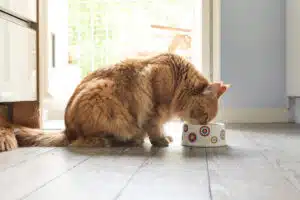Never assume that blood in your cat’s urine is normal; instead, get it checked out as soon as you can. You don’t need to head straight to an emergency clinic if your cat is urinating normally. But cats that are straining to urinate, passing little or no urine, yowling in the litterbox, or not urinating at all should be seen by a vet right away. The top five causes of a cat passing blood in its urination are as follows:
WHAT CAUSES BLOOD IN A CAT’S URINE?
- Feline lower urinary tract disease is the most frequent cause of blood in cats’ urination in this species. Other names for this syndrome include feline urologic syndrome and feline idiopathic cystitis (FIC). Uncertainty surrounds the precise cause of FLUTD in cats. According to current theories, the disease’s manifestation may be influenced by stress and obesity. Other theories include deficiencies in the biological “glue” of the bladder wall, viruses, and other components. Older theories held that this illness was caused by the ash content of the food or the pH of the urine.
- Blood can also be found in cat urine due to bladder stones. Other symptoms like yeowing and straining while urinating may also be present.
- uncommon urinary tract infections in young, healthy cats. Because of the anatomy of female cats, urinary tract infections are more prevalent in older cats.
- Another uncommon cancer is bladder cancer. Blood in the urine is one of the many symptoms cats with this illness can display.
- Blood in the urine has been known to occur in very young cats with urinary tract anatomical abnormalities.
WHAT TO DO IF YOUR CAT HAS BLOOD IN THEIR URINE?
- Make an appointment by calling your vet. Home remedies should not be used to treat this issue. Your cat may develop renal failure and pass away within days if it is unable to urinate. To check for various feline illnesses, your veterinarian may want to perform a number of tests. As examples, blood and urine samples, urine cultures, viral testing for feline leukemia and feline immunodeficiency virus (FIV), or physical examinations on your cat, such as taking x-rays or performing an abdominal ultrasound, can all be used.
- If your cat has FLUTD, follow the veterinary diet recommendations given to you by your doctor. When a cat feels better, owners frequently stop feeding it the recommended diet, but studies have shown that veterinary diets significantly lower the likelihood of relapse by over 80%. Changing a food to a different diet is the most frequent reason for a relapse. The typical “urinary tract” diets sold in pet stores are inappropriate for these cats.
- Some ways to increase your cat’s water intake include feeding canned food (see why in our recent blog post about the best wet cat food), using water fountains, adding a few drops of tuna juice to the water, using filtered water, or using big, clear water bowls.
Make an appointment with your veterinarian if your cat has blood in his urine. He will feel better faster the sooner you act.














